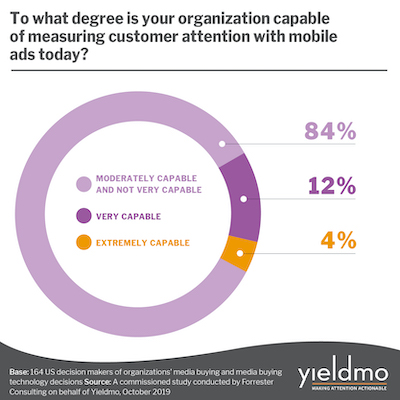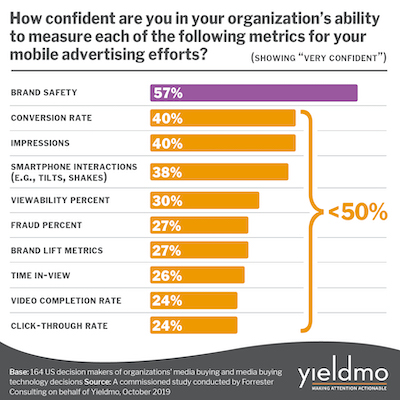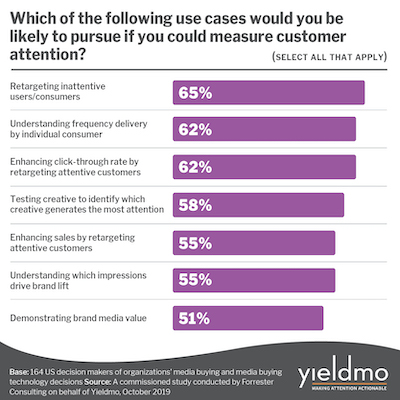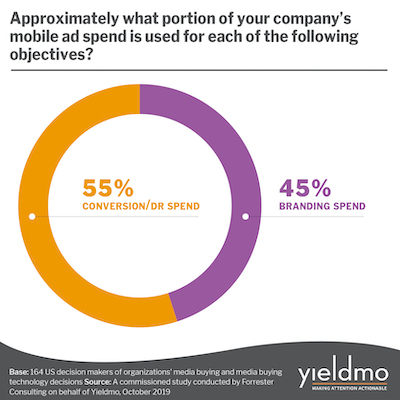
Viewability has been hailed as the holy grail metric across desktop, mobile and tablet (and now, even TV/Video) for some time, with many brands and publishers relying on the Media Rating Council (MRC) standards as a yardstick.
But user behavior across these channels couldn’t be more different than cats are to mice.
Suffice to say, measuring the full value of mobile advertising has been a great challenge. What with the varying screen sizes, ad formats, functionalities and contexts, there hasn’t been a true way for marketers to understand how to measure customer attention.
A new Yieldmo-commissioned report, “Attention 2.0: Enhancing Ad Measurement Beyond Clicks & Viewability—How Customer Attention Metrics Can Improve Mobile Advertising Outcomes,” from Forrester Consulting highlights the glaring gap between what marketers know how to measure in mobile advertising versus what they wish they could measure—and more importantly, how those metrics could impact advertising performance.
84% of marketers said their organizations are not capable of measuring customer attention with mobile ads. And, even the marketers who claim to measure customer attention can’t say which metrics they have or how they’re being used.
AdMonsters spoke with Lisa Bradner, General Manager of Data & Analytics, Yieldmo, to learn more about the report’s findings as well as gain more insight into the role publishers could play in helping marketers solve this Rubik’s Cube we know as mobile metrics. For their part, Yieldmo believes the report’s data underscores the company’s hypothesis that attention analytics will be the next evolution of viewability.
Lynne d Johnson: Why is it so complicated to understand consumer interest and intent on smartphones?
Lisa Bradner: It’s complicated to understand consumer intent PERIOD—we are not always linear and logical creatures and decoding those signals is a big part of what marketing insights and data teams are all about.
As smartphones are rapidly becoming people’s first screens where they do everything from watching their favorite shows to doing their online banking it becomes even more critical to understand the mobile piece of the puzzle…and it’s complicated by the size of the screen, the number of functions of the device and an ad ecosystem that’s still figuring out how to design for a mobile world.
LdJ: An issue highlighted in the report was the lack of a consistent understanding or definition around what customer attention in mobile means. How do you define customer attention when it comes to mobile and what can be done to create a common understanding across the board?
LB: Interestingly a lot of our survey respondents used metrics like traffic and viewability as proxies for attention—we think it goes a lot deeper. We define attention as “all the discrete behaviors a consumer exhibits on their mobile devices to signal involvement while looking at an advertisement.” Examples of attention might include tilts, horizontal swipes, scrolls, views and other ways that people engage on their mobile devices.
LdJ: Attention analytics is an emerging area as advertisers are beginning to realize that just because an impression was viewable or brand-safe doesn’t mean someone actually saw it.
LB: We’re working with a number of partners in the industry toward developing a common approach to attention metrics and best practices for using them appropriately. We’re excited to be at the forefront of evolving digital advertising metrics.
LdJ: Which events or signals should marketers be tracking to get a full view of the consumer journey in mobile? And, how will this view help to improve retargeting and reengagement efforts, as customers move further down the funnel?
LB: It’s not a one size fits all answer: we work with our clients to understand the KPIs that matter to them and use our data to find and model the signals that deliver on their goals. We then use these signals to optimize targeting of users, creative and inventory. We find commonalities across campaigns and categories but creative and media matter.
As marketers start to understand what messages are breaking through, where and with whom in real-time they can start to optimize things like frequency, message sequencing, retargeting and create ad experiences personalized to user behavior.
LdJ: How important is it to create mobile ads for engagement vs conversion and how can brands and publishers accomplish this?
LB: Both engagement and conversion are important—one of the misconceptions about mobile is that it’s just a direct response medium but our survey respondents use mobile for both brand and demand activities which just makes SENSE. If I’m streaming a show on my mobile device while on my commute I’m in a completely different state of mind then if I’m shopping for a pair of shoes—most of us do both but we’re going to be receptive to a different type of ad message in each of those scenarios.
Content and context always matter in media and it’s about matching those to the right environments. Our attention signal can help advertisers understand when they’re getting it right and when maybe they aren’t and our machine learning models can help advertisers and publishers match inventory and opportunity.
LdJ: As mentioned in the report, investing in the right ad tech is definitely one way that brands can get a clearer picture of mobile ad effectiveness, but is there also a way that publisher partners can better help brands to understand customer attention metrics?
LB: Absolutely. Publishers are in an increasingly strong position with valuable first-party data that can help them differentiate audiences and inventory. We’re working with our publisher partners to connect our attention signal to their audience and placement data to help deliver the most relevant audiences to advertisers and the most compelling advertising experience to consumers.
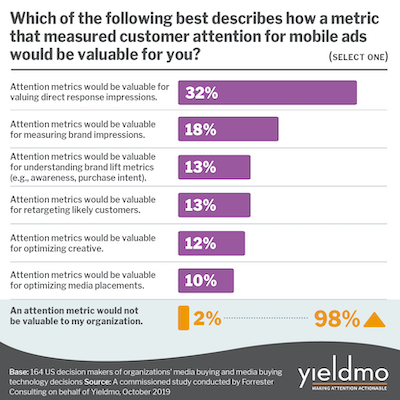
Nearly 80% of marketers are hungry for better customer attention data, while 63% of respondents said they plan to invest in customer attention metrics.
A majority of respondents said they were interested in gaining deeper insights around customer behavior and interactions with mobile ads (e.g., the attention your customer gives an ad)—30% said they were extremely interested, while 49% and 13% said they were very and moderately interested, respectively.
Could attention analytics be the next mobile metric?
